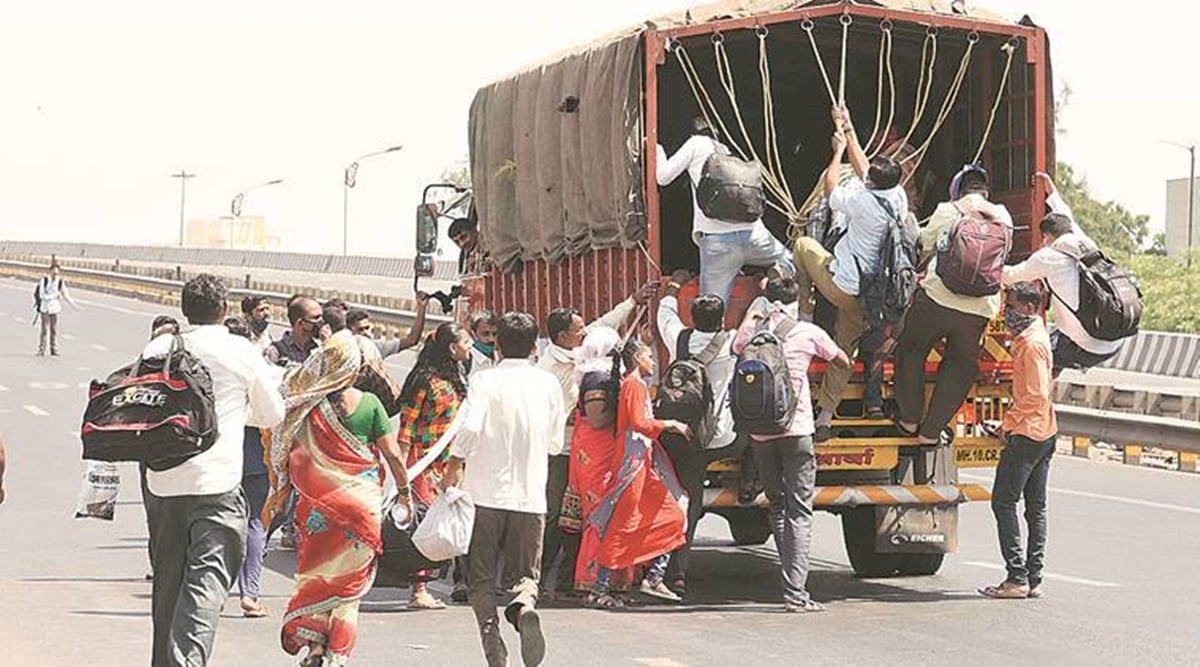 According to the report, following the Covid-19 lockdown last year, “approximately one lakh” migrant workers returned to their villages in Dahod.
According to the report, following the Covid-19 lockdown last year, “approximately one lakh” migrant workers returned to their villages in Dahod. IN A report released by Chief Minister Vijay Rupani last week, the state government has hailed the Mahatma Gandhi National Rural Employment Guarantee Act (MGNREGA) as a “lifesaver” for migrant workers who had to return to their villages in Gujarat following the Covid-19 lockdown last year.
The report also says that agriculture “cushioned” migrant workers, and the government should “prioritise agriculture” as a solution to the crisis.
Citing specific examples from villages in the predominantly tribal district of Dahod among others, the report says the state government should “re-strategise MGNREGA” — a scheme launched by the previous Congress-led UPA government in 2006 — as a solution for post-Covid rural recovery, and should “include skill-mapping, long-term risk coverage and income assurances”.
The report, Implications of Covid-19 on Gujarat on energy, emissions, climate and developmental perspectives, has been “prepared by the (state government’s) climate change department and supported by the Indian Institute of Management-Ahmedabad and the Indian Institute of Technology-Gandhinagar”.
According to the report, following the Covid-19 lockdown last year, “approximately one lakh” migrant workers returned to their villages in Dahod. Stating that “the government is working towards generating employment opportunities”, it says “MGNREGA has been a lifesaver for labourers compelled to return to their homes”.
In Dhara Dongri village of Dahod, migrant workers with small land holdings and no irrigation facilities enrolled themselves under MGNREGA, it says. “Although in comparison to what they were earning in cities, the wages under MGNREGA are minimum (Rs 224 per day), but they still consider it to be sufficient to sustain their families during such a crisis situation induced by Covid-19,” says the report.
Citing the example of a contractual worker from the same village, the report narrates how MGNREGA played a “positive role”. He cultivated maize on his small farm, which was sufficient to feed his family, and enrolled himself under MGNREGA.
Another couple from Pavdi village in Dahod found “income support” in MGNREGA after returning from Surat, where they were employed in a tile manufacturing unit, it says.
Citing a report in The Indian Express, it says that Dahod has the highest labour engagement under MGNREGA in Gujarat (2.38 lakh), followed by Bhavnagar (77,659) and Narmada (59,208).
“Agriculture has been able to cushion migrant workers from the Covid crisis by providing them with some subsistence earnings. Return of migrants to villages also helped in managing shortage of agricultural labourers,” says the report.
Citing the example of migrant workers in Saurashtra, it says: “These migrants were mostly engaged with the diamond sector in Surat, and those migrant households with land holdings in villages have opted for land tilling activities, while others engaged themselves as agricultural labourers.”
Over 12 lakh diamond workers in Surat are from Saurashtra and North Gujarat.
The report says the government should “prioritise agriculture” as part of a solution for migration. There is a “need for long-term strategy that takes into account underlying causes of migration including the links between agricultural policies and causes of migration,” it says.
Speaking to The Indian Express on condition of anonymity, an official from the climate change department said: “It is felt that MGNREGA received enormous stimulus under the AatmaNirbhar Bharat Abhiyan… Enrolment under the scheme increased enormously during the pandemic, and especially during the lockdown. Dahod district reported the highest labour engagement under MGNREGA, with most of them employed under the Pradhan Mantri Awas Yojana and Sujalam Sufalam Jal Sanchay Yojana… 12,378 households were employed in April and 77,429 in May. With increase in daily wages from Rs 198 to Rs 224, they managed to sustain their livelihood.”
- The Indian Express website has been rated GREEN for its credibility and trustworthiness by Newsguard, a global service that rates news sources for their journalistic standards.

